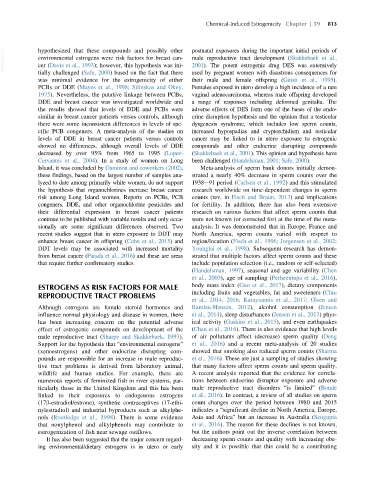Page 855 - Veterinary Toxicology, Basic and Clinical Principles, 3rd Edition
P. 855
Chemical-Induced Estrogenicity Chapter | 59 813
VetBooks.ir hypothesized that these compounds and possibly other postnatal exposures during the important initial periods of
male reproductive tract development (Skakkebaek et al.,
environmental estrogens were risk factors for breast can-
2001). The potent estrogenic drug DES was extensively
cer (Davis et al., 1993); however, this hypothesis was ini-
tially challenged (Safe, 2000) based on the fact that there used by pregnant women with disastrous consequences for
was minimal evidence for the estrogenicity of either their male and female offspring (Giusti et al., 1995).
PCBs or DDE (Mayes et al., 1998; Silinskas and Okey, Females exposed in utero develop a high incidence of a rare
1975). Nevertheless, the putative linkage between PCBs, vaginal adenocarcinoma, whereas male offspring developed
DDE and breast cancer was investigated worldwide and a range of responses including deformed genitalia. The
the results showed that levels of DDE and PCBs were adverse effects of DES form one of the bases of the endo-
similar in breast cancer patients versus controls, although crine disruption hypothesis and the opinion that a testicular
there were some inconsistent differences in levels of spe- dysgenesis syndrome, which includes low sperm counts,
cific PCB congeners. A meta-analysis of the studies on increased hypospadias and cryptorchidism and testicular
levels of DDE in breast cancer patients versus controls cancer maybelinkedtoinutero exposure to estrogenic
showed no differences, although overall levels of DDE compounds and other endocrine disrupting compounds
decreased by over 95% from 1965 to 1995 (Lopez- (Skakkebaek et al., 2001). This opinion and hypothesis have
Cervantes et al., 2004). In a study of women on Long been challenged (Handelsman, 2001; Safe, 2000).
Island, it was concluded by Gammon and coworkers (2002), Meta-analysis of sperm bank donors initially demon-
these findings, based on the largest number of samples ana- strated a nearly 40% decrease in sperm counts over the
lyzed to date among primarily white women, do not support 1938 91 period (Carlsen et al., 1992) and this stimulated
the hypothesis that organochlorines increase breast cancer research worldwide on time-dependent changes in sperm
risk among Long Island women. Reports on PCBs, PCB counts (rev. in Fisch and Braun, 2013) and implications
congeners, DDE, and other organochlorine pesticides and for fertility. In addition, there has also been extensive
their differential expression in breast cancer patients research on various factors that affect sperm counts that
continue to be published with variable results and only occa- were not known (or corrected for) at the time of the meta-
sionally are some significant differences observed. Two analysis. It was demonstrated that in Europe, France and
recent studies suggest that in utero exposure to DDT may North America, sperm counts varied with respect to
enhance breast cancer in offspring (Cohn et al., 2015)and region/location (Fisch et al., 1996; Jorgensen et al., 2002;
DDT levels may be associated with increased mortality Younglai et al., 1998). Subsequent research has demon-
from breast cancer (Parada et al., 2016) and these are areas strated that multiple factors affect sperm counts and these
that require further confirmatory studies. include population selection (i.e., random or self-selected)
(Handelsman, 1997), seasonal and age variability (Chen
et al., 2003), age of sampling (Perheentupa et al., 2016),
ESTROGENS AS RISK FACTORS FOR MALE body mass index (Guo et al., 2017), dietary components
including fruits and vegetables, fat and sweeteners (Chiu
REPRODUCTIVE TRACT PROBLEMS
et al., 2014, 2016; Karayiannis et al., 2017; Olsen and
Although estrogens are female steroid hormones and Ramlau-Hansen, 2012), alcohol consumption (Jensen
influence normal physiology and disease in women, there et al., 2014), sleep disturbances (Jensen et al., 2013) phys-
has been increasing concern on the potential adverse ical activity (Gaskins et al., 2015), and even earthquakes
effect of estrogenic compounds on development of the (Chen et al., 2016). There is also evidence that high levels
male reproductive tract (Sharpe and Skakkebaek, 1993). of air pollutants affect (decrease) sperm quality (Deng
Support for the hypothesis that “environmental estrogens” et al., 2016) and a recent meta-analysis of 20 studies
(xenoestrogens) and other endocrine disrupting com- showed that smoking also reduced sperm counts (Sharma
pounds are responsible for an increase in male reproduc- et al., 2016). These are just a sampling of studies showing
tive tract problems is derived from laboratory animal, that many factors affect sperm counts and sperm quality.
wildlife and human studies. For example, there are A recent analysis reported that the evidence for correla-
numerous reports of feminized fish in river systems, par- tions between endocrine disruptor exposure and adverse
ticularly those in the United Kingdom and this has been male reproductive tract disorders “is limited” (Bonde
linked to their exposures to endogenous estrogens et al., 2016). In contrast, a review of all studies on sperm
(17β-estradiol/estrone), synthetic contraceptives (17-ethi- count changes over the period between 1980 and 2015
nylestradiol) and industrial byproducts such as alkylphe- indicates a “significant decline in North America, Europe,
nols (Routledge et al., 1998). Thereis someevidence Asia and Africa” but an increase in Australia (Sengupta
that nonylphenol and alkylphenols may contribute to et al., 2016). The reason for these declines is not known,
estrogenization of fish near sewage outflows. but the authors point out the inverse correlation between
It has also been suggested that the major concern regard- decreasing sperm counts and quality with increasing obe-
ing environmental/dietary estrogens is in utero or early sity and it is possible that this could be a contributing

